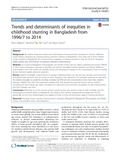Trends and determinants of inequities in childhood stunting in Bangladesh from 1996/7 to 2014

View/Open
Date
2016-11-16Publisher
© 2016 International Journal for Equity in HealthMetadata
Show full item recordCitation
Rabbani, A., Khan, A., Yusuf, S., & Adams, A. (2016). Trends and determinants of inequities in childhood stunting in Bangladesh from 1996/7 to 2014. International Journal for Equity in Health, 15(1), 1–14. https://doi.org/10.1186/s12939-016-0477-7Abstract
Background
We explore long-term trends and determinants of socioeconomic inequities in chronic childhood undernutrition measured by stunting among under-five children in Bangladesh. Given that one in three children remain stunted in Bangladesh, the socioeconomic mapping of stunting prevalence may be critical in designing public policies and interventions to eradicate childhood undernutrition.
Methods
Six rounds of Bangladesh Demographic and Health Survey data are utilized, spanning the period 1996/97 to 2014. Using recognized measures of absolute and relative inequality (namely, absolute and relative difference, concentration curve and index), we quantify trends, and decompose changes in the concentration index to identify factors that best explain observed dynamics.
Results
Despite remarkable improvements in average nutritional status over the last two decades, socio-economic inequalities have persisted, and according to some measures, even worsened. For example, expressed as rate-ratios, the relative inequality in under-five stunting increased by 56% and the concentration index more than doubled between 1996/97 and 2014. Decomposition analyses find that wealth and maternal factors such as mothers’ schooling and short stature are major contributors to observed socio-economic inequalities in child undernutrition and their changes over time.
Conclusions
Reflecting on recent success around socioeconomic and gender equity in child mortality, and the weak legacy of nutrition policy in Bangladesh, we suggest that nutrition programming energies be focused specifically on the most disadvantaged and applied at scale to close socioeconomic gaps in stunting prevalence.
